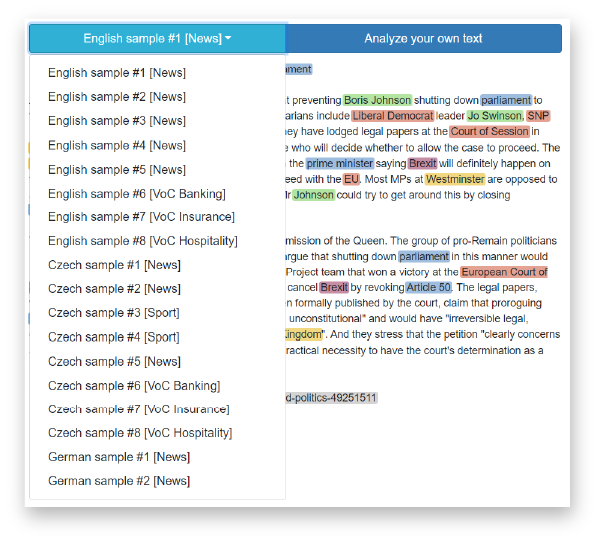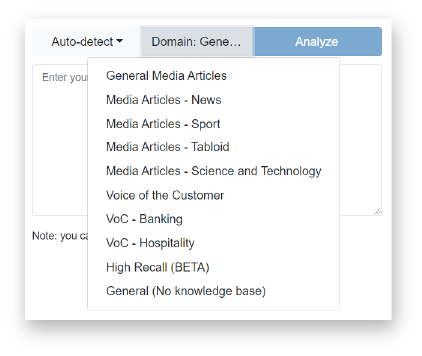Have you ever tried our demo at demo.geneea.com? If you have, you will know that it’s a fun way to try out our natural language processing (NLP) software. But maybe you don’t know about everything it can do. If you haven’t – well, now is the best time to try it!
Let me show you why.
In the demo, you can either choose from one of our samples – there are news articles and customer reviews in several languages – or analyze a text of your choice. We currently support eight languages and are steadily adding more.
For a sample of just a few words, it’s best to specify the language, but for more than one sentence, you need not bother – the system will recognize the language automatically.
By default, the demo expects your text to be a news article. But what if you want to see how it will cope with a review from one of your customers? That’s what Voice of the Customer (VoC) is for. Just click on the middle button and choose one of the VoC options.
Now press Analyze and watch the magic happen. Even if you choose one of the sample texts, the demo analyzes it anew each time. You always see up-to-date results. And what exactly will you see?
Tags
If you work in media, you may be most interested in the Tags section. Tags are chosen from the most important entities for the text, based on internal scoring. We’ve recently improved our algorithm for selecting tags. It works with what our Interpretor finds in your text, and also on how this links to our Knowledge Base. When you point to a tag or entity, you will see where in the text it was found. If you click, you’ll see information from the Geneea Knowledge Base (GKB) – a description and links to Wikipedia and other sources, if available.

Photo suggestions
Next, you might check out the Photo suggestions. Our Photo Assistant analyzes the text and suggests relevant photos. It can even find photos from a Czech photo database for an English text, and vice versa. For now, we are working with the Czech News Agency’s photos, but more sources will be added soon. Click on the little arrow to see more suggestions based on various entities. Clicking on a photo will take you to its page in the photo database.

Sentiment
Another interesting aspect is the Sentiment. This is particularly important for Voice of the Customer – it shows you straight away whether your customer was impressed or disappointed with the offered service. Sentiment is predicted at sentence level, and can be any one of four values: positive 🙂, negative 🙁, neutral 😐, and ambivalent 😕. For instance, if in one sentence your customer mentions great service but in another that the food wasn’t good, the first sentence scores a positive sentiment, the second a negative sentiment, and the text as a whole will be graded as ambivalent.
Entities
I mentioned that tags are selected from entities, but what about the entities themselves?
In media domains, there are six types: person, organization, location, product, event, and general. (Plus dates, numbers, etc.)
In VoC domains, the entities are relative to the topic.

In all domains, you can highlight a single entity (by pointing your cursor at it) or a whole section (by hovering over the section next to individual entities).
You can also toggle the Entities into tabular view (use the icon in the top right corner) and choose to sort them by name, Geneea ID, type, or number of occurrences.

Attributes & Relations
Recently, we have added new features which are of interest particularly to VoC domains (and to all syntax lovers): Attributes (relative to nouns) and other Relations (mostly relative to verbs).


These features enable you to see certain relevant information more easily, because they pick up the same properties from all kinds of sentences. For instance, it doesn’t matter if the customer writes “The pizza was totally cold” or “They brought me a cold pizza” – both will yield the attribute cold for pizza.
Attributes and Relations are currently supported for English and Czech.
Did you enjoy the features in our demo? Do you think they would make life easier for you or your colleagues or employees? There is nothing easier than implementing our API in your own workflow. Contact us at info@geneea.com and we will help.








